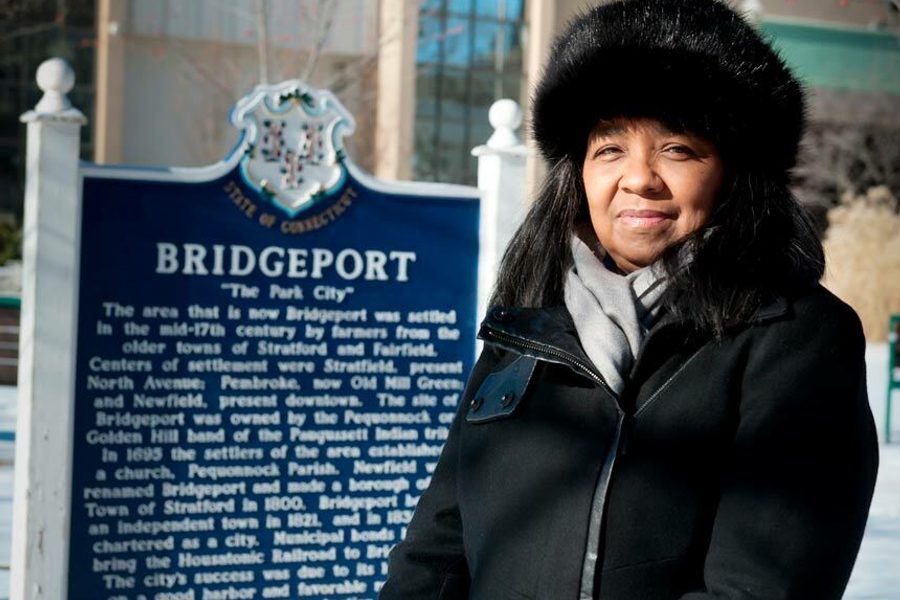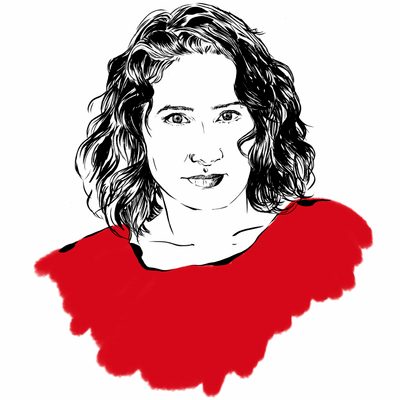The Third Party That’s Winning
With new strategies, the Working Families Party is shaking up the two-party system.
Sarah Jaffe

Sauda Baraka didn’t pursue a spot on the Bridgeport, Conn., Board of Education thinking it would be a springboard to higher office. As her children went through Bridgeport’s public schools, she saw herself simply as an “involved parent” — until 2004, when the Republican Party recruited her to run for the board. Connecticut reserves three seats on all school boards for a minority party — and at the time in Bridgeport, long dominated by a Democratic Party machine, the minority party was Republican. She accepted, and won.
After Baraka spent four years pressing for more funding for the schools and more transparency about operations, the Republicans “kicked me to the curb,” she tells In These Times. “I guess they didn’t like my politics.”
Baraka’s distaste for corporate-style education reform didn’t endear her to the Democrats in the city, either; as in many places around the country, school privatization is a bipartisan affair. But she didn’t give up. Instead, she made plans to run that year as an independent. Then a friend of hers introduced her to the Connecticut Working Families Party (WFP), which was considering a bid for those minority spots on the board. “I liked the grassroots process,” Baraka says. “I liked what they were saying. I liked what their platform was. I could support pretty much everything that they were doing.” She ran on the WFP ticket in 2009 and won, as did another WFP candidate for the board, Maria Pereira.
After years of battle in Bridgeport, the WFP emerged victorious from the 2013 elections with a functional majority of the nine-member school board — two members from the Working Families Party and three WFP-backed Democrats — and Baraka as the chair.
That was just one of several big successes for the Working Families Party around the country this fall, perhaps the most notable being the election of Mayor Bill de Blasio and a progressive slate of candidates in New York City — including Public Advocate Letitia James, the first black woman to hold citywide office, and Melissa Mark-Viverito, the first Latina Speaker of the Council. These WFP candidates are expected to push a progressive agenda for New York that includes expanding paid sick days, levying a tax on the wealthy to fund universal pre-kindergarten, and much more.
The New York City victories have attracted new attention to how the WFP exercises power at the ballot box and in city and state legislatures, leveraging quirks in local electoral systems and existing progressive bases to make a third party viable.
But it is the ways that Working Families is wielding its power outside of liberal New York that deserve a closer look. As public discontent with mainstream Democrats builds, is it possible for a third party to grow — not by running a famous big name on a presidential ticket, but from the bottom up? And if it succeeds at that task, can Working Families pull national politics back in the direction of ordinary people and away from the 1%?
Political fusion
In the states of Connecticut, New York and Oregon, the Working Families Party relies on “fusion voting” in order to hold a slot on the ballot. Fusion voting, operative in eight states, allows a candidate to be simultaneously endorsed by multiple parties; New Yorkers could vote for Bill de Blasio, for example, on either the Democratic or the WFP ballot line. This allows voters to express support not just for the candidate but for the party’s ideals, without the party acting as “spoiler,” a charge often leveled at minor parties. Cross-endorsing big-name candidates can help the party draw votes, allowing it to meet the minimum vote threshold to stay on the ballot in the next election without a time-consuming petition process. Having that slot in turn means the party can — although it rarely does— run its own independent candidates, counting on voters to support them because they know and like the WFP.
The WFP’s predecessor, the New Party, was founded in 1990 by Dan Cantor and Joel Rogers on the conviction that passing fusion voting on a national level was the best chance of breaking the two-party deadlock. When a challenge to state laws that banned fusion failed in the Supreme Court, the New Party fell apart. But Cantor, along with Bob Master of the Communications Workers of America and Jon Kest, then of ACORN, decided to build on fusion where it existed, beginning in New York. In 1998, they founded the Working Families Party there.
However, much of the power the WFP built — championing issues, winning primaries — didn’t involve fusion at all, and many of those tactics can be exported to non-fusion states. Cantor, the Working Families national director, says, “As much as we like fusion voting, it’s not essential to the actual advance of the project.”
So in New Jersey, Pennsylvania, Maryland and Washington, D.C., where fusion is not available, Working Families is beginning to operate as an independent political organization. It plans to build campaigns around issues like paid sick days, press officials to support them, and train candidates to run in both primary challenges and general elections.
The point, for Cantor, is to build an independent power base in both fusion and non-fusion states that can pull the political discussion back in a progressive direction. He notes that the Tea Party didn’t just push Republicans rightward, but Democrats as well.
When the major parties agree, as they often do in supporting, say, corporate-style education reform, a third party can promote ideas and issues that would be otherwise neglected. In Oregon, for example, the WFP worked with local student groups to put forward a plan for rethinking college funding. They found a WFP-backed Democrat to sponsor it, and the measure wound up passing unanimously in the state legislature. The party is now working on a bill that would create a state bank to invest Oregon’s public money at home instead of with Wall Street and provide cheaper loans to state residents. Such proposals are unlikely to come from the major parties, which each receive massive campaign contributions from big banks, even at the state level.
Around the country, the party also backs familiar proposals like paid sick leave and an increase in the minimum wage. Though these initiatives didn’t originate with the WFP, the party’s 15 years of clout has given it enough leverage in the states where it works to demand politicians take a position. Elected officials who have had or want the WFP’s backing— which means on-the-ground support come election time as well as a stamp of progressive approval — have an incentive to back its policies.
“Power has both an ideological element and a straight political muscle element,” says Cantor. “Can you actually deliver the energy, ideas, troops, money, tactics, morale, volunteers that are needed in any given fight? The fight might be an issue campaign or an electoral campaign. What I think is quite delightful about Working Families is we do both.”
A minority model
The WFP’s decision to run independent candidates in Bridgeport marked a departure from the party’s usual M.O. of flexing its muscles within the Democratic Party by recruiting or endorsing progressive Democrats in primaries. But the minority representation rules in Connecticut presented another opportunity for a third party to gain ground.
It wasn’t easy. After the victories of the WFP candidates, Baraka continued the fight she’d begun against the agenda of the board’s majority, asking for more funding for programs and more information on what was happening, now with Pereira on her side. No one expected the school board’s Democratic majority to vote itself out of existence, but that’s what happened next. Its then-president, Barbara Bellinger, with the support of five other board members and the mayor of Bridgeport, requested that the state Board of Education replace the entire board with appointed members. The state Supreme Court ruled that move unconstitutional, but the appointed board had already hired a new interim superintendent: Paul Vallas, famous (or infamous) for his time in New Orleans, Philadelphia and Chicago laying off teachers and promoting charter schools. In 2012, Bridgeport mayor Bill Finch and his pro-charter-school allies put elimination of board elections on the ballot, where, despite $200,000 from Michelle Rhee’s StudentsFirst and $25,000 from billionaire ex-New York City mayor Michael Bloomberg, it went down in flames.
After all that, says Lindsay Farrell, the executive director of the Connecticut WFP, it was clear that the party needed more than two members on the board. “We made a strategic decision that in addition to running our own folks, we also needed to run folks in a Democratic primary who would work with our Working Families Party officials to partner together on a more progressive agenda.”
Three new school board members rode their WFP endorsements to victory in Democratic primaries and then the general election. Combined with Baraka, now the board chair, and another WFP member, they’ll have a functional majority on the board — a majority that is opposed to charter schools, Teach for America and the other facets of the corporate school reform agenda — and perhaps another blueprint for party-building.
New territory
The Bridgeport school board wasn’t the only legislative body shaken up in the 2013 elections. This fall, voters expressed a rising discontent with business-as-usual bipartisan politics across the country. Socialist Kshama Sawant won a city council seat in Seattle, another socialist, Ty Moore, came close to victory in Minneapolis, and an independent labor slate took two dozen council seats in Lorain County, Ohio. Around the country, there are noises about independence from the Democratic Party — perhaps the loudest coming from Chicago, where the Chicago Teachers Union is joining other labor and community groups to form an independent political organization.
All this could spell good news for Working Families as it moves to expand. In Pennsylvania, for instance, the events in Bridgeport inspired Andi Perez — executive director of Youth United for Change, a youth-led Philadelphia organization that fights to improve the city’s public schools — to be part of the launch of a new state-level Working Families coalition.
Though the state doesn’t have fusion voting, there are other ways for a Working Families organization to have an impact. Without a ballot line, Working Families will consider endorsing candidates in primaries, on-the-ground organizing around issues such as wages, taxes and school funding, and perhaps eventually running City Council candidates in Philadelphia, which has minority representation rules similar to those in Bridgeport.
In a polarized state like Pennsylvania, whose cities are held in an iron grip by Democratic Party machines and whose rural areas often support far-right politicians like Republican Gov. Tom Corbett, bringing in a third party might shake up hidebound preconceptions. Or at least, that’s what Gabe Morgan hopes. Morgan and the union he directs, the building service workers’ local SEIU 32BJ Pennsylvania, are helping to set up the state’s Working Families organization. Previously, they were part of a coalition in Pittsburgh that ousted machine Dems in the 2013 city elections, endorsing a slate of primary challengers who went on to win in the general election, including Pittsburgh’s new mayor, Bill Peduto. It wasn’t a Working Families Party effort, but Morgan sees it as emblematic of what he’d like to do with Working Families.
“The goal is to build an organization that really does try and speak for working-class people in Philadelphia,” he says. “For it to work and be meaningful, it’s got to be organic to the place that it’s in. What we build in Philadelphia won’t be the exact same as New York and won’t be the exact same as Pittsburgh and won’t be the exact same as Connecticut.”
The new organization has already held a candidate forum for Democrats interested in challenging Corbett for the governorship. Its gaze is firmly set on fixing Philly’s badly broken school system, currently under the control of a state government that has slashed funding, eliminated programs and shuttered schools. It also has its sights on improving poverty-wage jobs at the Philadelphia airport and changing liberal— “liberal in a bad way,” Morgan says — tax abatements for businesses that wind up gentrifying neighborhoods without paying back into local schools.
For Perez, the Working Families umbrella is a way to solidify alliances that already exist: between unions and community organizations, between individuals and institutions, and connect all those progressive players to something bigger — a growing party. “We’re only going to build our power working together,” she says.
The non-union working class
In order to really build that power, Gabe Morgan believes, the Working Families organization in Pennsylvania has to stretch “across lines — not just union members but all working-class people.” These days, most of those people are not members of a union or another organization. So for Working Families to become a truly mass organization, it will have to find a way to reach an increasingly atomized working class.
Of course, the WFP wouldn’t be what it is without the support of major unions and community groups; ACORN and the Communications Workers of America played key roles in getting the party off the ground, and 32BJ in New York has been an affiliate since early on. Bertha Lewis, former head of ACORN and now founder and president of the Black Institute, explains, “It was a principle that we had that, in order to be an affiliate [of WFP], you had to have members … you had to do real organizing, you had to do real actions, and you had to be on the ground.”
Cantor calls for a “healthy balance” between the two approaches. “You have to have institutional players,” he says. “I always think the job of the organizers in a given state is to keep in some kind of harmony the interests of the institutional forces with individual activists — in which the former provides relationships and resources and lots of people, and the second provides energy and ideas.”
Balancing the existing institutions with the needs of activists who aren’t part of a union or community organization can be a tough challenge, notes Michael Hirsch, a longtime labor activist, retired union staff writer, and WFP member. In 2000, he helped build one of New York’s first Working Families Party clubs on Manhattan’s East Side. They met monthly and canvassed their neighborhoods around issues and candidates the party supported as members — but ultimately, the club didn’t last, in part because it wasn’t clear how they fit into the WFP’s framework, which gives decision-making seats to people who represent existing institutions. Such efforts, Hirsch says, are “messy and hard and require a lot of servicing,” but ultimately necessary. They might also provide a blueprint for how the party could one day spread into more conservative areas, where community organizations and unions have little presence, but working-class people might be open to hearing about higher wages and better healthcare and schools.
Since the party’s strategy often revolves around winning primaries, the easiest measurement of party “membership” goes out the window — you don’t want people to register as WFP members when that prevents them from voting in Democratic party elections. But Cantor explains that there is a “long arc of involvement” for people who want to support Working Families — from being on its email list and maybe donating some money, to joining a local group, to attending candidate screenings and meetings, to signing a “volunteer contract” pledging a certain amount of door-knocking or phone banking for candidates.“ All of it is valuable,” Cantor says.
As the party expands outside of its comfort zones, Cantor says, “The big challenge for us is: Can we figure out the form of [the] organization that people can identify with, feel good about [and] support with their feet and wallets?”
The Cuomo question
In New York, where the party began, the dust has barely settled around the city’s elections. But even as de Blasio’s win is heralded, the question of another New York Democrat comes up a lot for the Working Families Party: Governor Andrew Cuomo.
The Left has questioned the WFP’s candidate choices many times since its founding, but never more angrily than the decision to endorse Cuomo, who ran an economically conservative campaign and has governed in the same vein. Yet the New York governor’s race holds the key to the WFP’s ballot line. State rules require parties to get 50,000 votes in a governor’s race to keep their spot on the ballot, as the party did in 1998 when it made its first cross-endorsement of Democrat Peter Vallone. Though Vallone lost to George Pataki that year, the WFP netted 51,325 votes and gained the spot it has held ever since. Were it to lose its ballot line, it’d have to petition each time to have a candidate on the ballot.
Without endorsing Cuomo in 2010, the party feared it wouldn’t meet the 50,000-vote quota. Cuomo took advantage of the WFP’s position and pushed it to sign on to his whole agenda, which included tax cuts and worker pay freezes. Cuomo won easily and the WFP kept its ballot line, but it’s unclear whether he helped the party’s vote total. Sociologist and In These Times contributor Peter Frase (full disclosure: my boyfriend) crunched the numbers and found that in virtually every county, Cuomo got fewer WFP votes than any of the party’s other statewide cross-endorsed candidates. By contrast, when Eliot Spitzer was cross-endorsed by WFP in the 2006 gubernatorial race, he garnered more votes on the WFP line than the party’s lower-level candidates. While there’s no way to prove with certainty that an independent WFP candidate would have crossed the 50,000-vote threshold, Frase notes that the Green Party got 59,906 votes for its independent candidate, Howie Hawkins — suggesting that it was possible for a third party to hold a ballot line with a Left challenge to Cuomo.
The governor is up for re-election in 2014, and the party will no doubt face a lot of pressure from both the pro-Cuomo and anti-Cuomo crowds. But it’s hard to imagine a political climate both regionally and nationally more different than the one in which it made its choice last time, and it’s equally difficult to imagine a candidate more off-message for the current moment than Cuomo. His latest exploit, at press time, was to attempt to commandeer some $613 million of the $13 billion JP Morgan Chase mortgage-fraud settlement, supposed to be earmarked to help homeowners, into the state’s general fund, where he wanted to use it in part for tax cuts.
Moves like this, or like Cuomo’s play to create universal pre-kindergarten in the state without passing the tax increase on the wealthy to pay for it that was central to de Blasio’s campaign, are often portrayed as a clash of egos between Cuomo and de Blasio, or between Cuomo and Attorney General Eric Schneiderman. But they’re also about something broader — a shift in priorities, perhaps, or in power.
This is precisely why the question of Cuomo is bigger than just one candidate. It’s a question of power and who has it, within the WFP and without. In some ways, it is the question of the future of the WFP’s strategy.
To Hirsch, there’s only one answer: Run a candidate against Cuomo. “It’s a risk, [but] it’s a risk worth taking,” he says. The way forward would be difficult, but not impossible, he continues: “It would mean basically getting the unions to agree to disagree. It would mean trying to figure out if any union is willing to break with Cuomo. It would mean encouraging people of the Left who don’t do electoral work to do electoral work.”
The unions disagreed in 2013, too. SEIU 32BJ New York endorsed former City Council Speaker Christine Quinn in the mayoral primary; the United Federation of Teachers (UFT) went with onetime comptroller Bill Thompson, the Democratic nominee in 2009, and still others sided with comptroller John Liu. 1199SEIU and community group New York Communities for Change, also affiliates of the WFP, did endorse de Blasio. WFP was officially neutral in the primary because of the conflict.
It will be hard to get any union to break with a governor who appears certain to cruise to re-election. Hirsch believes, because of this, that it’s important to challenge him from the left.
It wouldn’t be the first time that the WFP agreed to disagree with some of its major affiliates, either. In Oregon, the party’s Pay It Forward plan for higher education funding met with stiff opposition from the UFT’s parent union, the American Federation of Teachers. Cantor says of that experience, “If you build an organization so that people develop a history of working together and build some trust, then you can disagree and it doesn’t blow up.”
An endorsement decision will happen in the coming months, and any prediction is probably premature, but the Party has certainly not remained silent in the face of Cuomo’s policies. A recent WFP press release put it this way: “The governor’s trickle-down plan, replete with estate and corporate tax cuts, only serves to cement New York’s status as the inequality capital of the world.”
It all comes down, in the end, to how power gets built. It requires coalitions and trust; institutional support and enthusiastic activists; lots of organizing, and perhaps most of all, a willingness to pick the right fights.
Bertha Lewis knows perhaps better than anyone else how hard those fights can be. But she thinks they’re worth it. “Sometimes, in years past, you couldn’t tell a Democrat from a Republican. No one wanted to talk about race; no one wanted to talk poverty. This whole conversation that we’re having nationally about inequality is because [groups like WFP] kept to our principles and our ideas and kept saying, ‘There is inequality, there is inequality, there is inequality.’ ”
“We found our muscle,” she says.
Sarah Jaffe is a writer and reporter living in New Orleans and on the road. She is the author of Work Won’t Love You Back: How Devotion To Our Jobs Keeps Us Exploited, Exhausted, and Alone; Necessary Trouble: Americans in Revolt, and her latest book is From the Ashes: Grief and Revolution in a World on Fire, all from Bold Type Books. Her journalism covers the politics of power, from the workplace to the streets, and her writing has been published in The Nation, The Washington Post, The Guardian, The New Republic, the New York Review of Books, and many other outlets. She is a columnist at The Progressive and In These Times. She also co-hosts the Belabored podcast, with Michelle Chen, covering today’s labor movement, and Heart Reacts, with Craig Gent, an advice podcast for the collapse of late capitalism. Sarah has been a waitress, a bicycle mechanic, and a social media consultant, cleaned up trash and scooped ice cream and explained Soviet communism to middle schoolers. Journalism pays better than some of these. You can follow her on Twitter @sarahljaffe.









